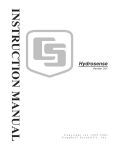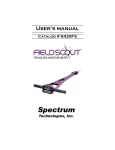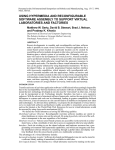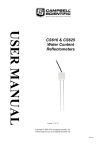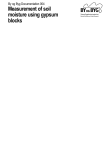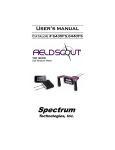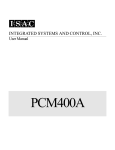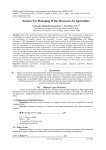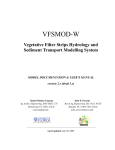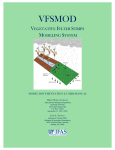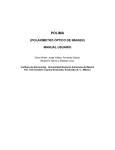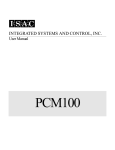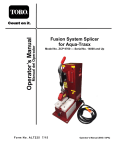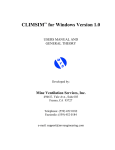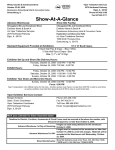Download Controlling Irrigation with Tensiometers and Time Domain
Transcript
Controlling Irrigation with Tensiometers and Time Domain Reflectometry (TDR) Final Report Dorota Z. Haman - Agricultural and Biological Engineering Thomas H. Yeager – Environmental Horticulture University of Florida Introduction In 1990, agriculture accounted for the largest use of freshwater in Florida. Agricultural water withdrawals amounted to 3,805 million gallons per day and provided irrigation water for 2.15 million acres (Carriker 2000). It is generally understood that water conservation is the best way to increase the water management efficiency of agriculture and reduce potential negative environmental impacts. Because of this need for conservation combined with other factors such as economics, labor, and product quality requirements, irrigators are under increasing pressure to manage water more efficiently. More precise irrigation management that uses reliable moisture sensors and irrigation controllers can significantly improve irrigation scheduling techniques that will result in higher irrigation efficiency. Irrigation scheduling may be accomplished by a number of different methods that strive to keep the soil moisture within proper limits. Proper irrigation scheduling is the application of water to crops only when needed and only in needed amounts. This requires the answer to two questions: when to irrigate and how much water to apply (Smajstrla, et al. 1997). No irrigation system will apply water without some waste or losses, since the cost to prevent all losses is prohibitive. An excellent method to reduce water use consists of utilizing soil moisture monitoring devices in conjunction with rainfall records and knowledge of plant water needs (Muñoz-Carpena, et al. 2002). The objective of this research project was evaluate two soil moisture sensors and make a progress in development of a useful and easy-to-use irrigation controller for container production of ornamental plants in Florida’s nurseries. Irrigation in Nurseries Most of the irrigation systems used in Florida container nurseries are pressurized irrigation systems, such as overhead sprinklers or some type of microirrigation. However, mainly due to the economics, the majority of Florida nurseries use overhead sprinkler systems, especially for small containers. Typically, the application efficiencies of these systems are low (20-50%) due to container spacing that is necessary for proper plant development (Haman, et al. 1996). Using microirrigation can increase the efficiency, however, these systems are more costly and require higher management skills. A big advantage of microirrigation is a fact that water is delivered directly to the root zone of the plants. For plants that are sensitive to foliar diseases, dry foliage will also be an advantage. Microirrigation systems are suited for chemigation (chemical application with 1 irrigation water). The water and chemicals are applied directly to the container substrate and there are no losses between containers, minimizing the runoff from the nursery. Furthermore, the danger of chemical loss and contamination is reduced (Haman, et al. 1997). However, the control of these irrigation systems is more complicated and a reliable device to monitor the water content of the substrate is needed for efficient water application. Irrigation Controller A controller is an integral part of an irrigation system. It is an essential tool to apply water in necessary quantity and at the right time to sustain agricultural production and to achieve high levels of efficiency in water and energy uses. These devices have evolved into complex computer-based systems that allow accurate control of water, energy and chemicals while responding to environmental changes and various development stages of the crop (Zazueta, et al. 1993). Closed loop controllers for irrigation systems base their irrigation decisions on direct measurement of soil-moisture using sensors like TDR. The simplest form of a closed loop control system is a timer with a moisture sensor that interrupts an irrigation cycle based on the moisture status or the soil, growth substrate, or plant water status. The system can be set to irrigate at a very high frequency, depending of the settings entered in the datalogger/controller program. When the controller attempts to irrigate, irrigation will occur only if the moisture sensor allows it, which in turn occurs only when substrate moisture dropped below acceptable level. The acceptable level is determined from recommendations for the type of plant to be cultivated, the environmental conditions, cultural practice, and the type of substrate used in the containers. Moisture Sensors for Container Substrate Many current irrigation systems used in container nurseries are based on timers and moisture sensors. However, few systems are controlled by moisture sensors in real time. Most of the soil moisture sensor have been developed for field conditions and function well when used in mineral soils. However, many sensors that work well in the field are not very reliable in the container substrate due to the poor contact between the substrate and the sensor. A good example of the sensor that often has problems due to poor contact is a tensiometer. In addition to contact problem the amount of water that filters from the tensiometer ceramic cup to the substrate could be relatively high compared to the total volume of a small container (i.e. 1 gallon container), especially when the substrate is dry. As a result, the container with the tensiometer could show a water content greater than the actual water content of containers without a tensiometer. Other devices, such as gypsum blocks are also affected by the porosity of the substrate used in containers. In addition, gypsum blocks dissolve with time and have to be replaced often after one year of operation (Muñoz-Carpena, et al. 2002). Tensiometer Tensiometers are usually capable to read in the range of water tensions between Field Capacity (FC) and Maximum Allowable Depletion (MAD) for a substrate used in container production. The main problem that can be expected with tensiometers when used with substrates with more than 70% porosity, is to maintain enough contact between the ceramic cup and the substrate. To improve the contact, the substrate around tensiometer must be carefully pressed 2 during sensor installation. Short tensiometers are more suitable for small container production since they fit more easily in the container and do not add water to the substrate via capillarity when the substrate is dry. Time Domain Reflectometry (TDR) A precise and relatively new technology to assess volumetric soil water content is the Time Domain Reflectometry (TDR). TDR voltage readings can be converted into volumetric soil water content (VSWC) which is a popular method to report the soil water status. A fully automatic system containing this kind of sensors requires a datalogger or computer to activate the solenoid valves that control the operation of the irrigation system. TDR sensors give very accurate readings, however, they are still quite expensive (approximately $200 per sensor) and additional hardware and software is needed to control an irrigation system using TDR (Charlesworth 2000). In a TDR probe the speed of an electromagnetic signal passing through a material varies with the dielectric material. A signal is sent down steel probes buried in the media. When it reaches the end of the probes it is reflected back to the TDR receptor unit. The difference in time that takes the signal to return is caused by the dielectric constant that is affected by the water content of the substrate that surrounds the probes. The levels of voltage received by a TDR probe are converted into volumetric soil water content (VSWC). Soil Water Content The gravimetric soil water content (GSWC) is expressed by weight as the ratio of the mass of water to the dry weight of the soil sample. To determine this ratio for a particular soil sample, the water mass must be determined by drying the soil to constant weight and measuring the soil sample mass after and before drying (Black 1965). The water mass (or weight) is the difference between the weights of the wet and oven dry samples. The oven-drying technique is probably the most widely used of all gravimetric methods for measuring soil moisture and is the standard for the calibration of all other soil moisture determination techniques (Black 1965). Volumetric soil water content (VSWC) relates volume of water in the sample to the total volume of soil and it is a more convenient way to express the soil moisture content for irrigation management. VSWC can be calculated by multiplying the gravimetric soil water content (GSWC)) by the soil bulk density (mass of soil solids per unit volume) (Charlesworth 2000). Materials and Methods A greenhouse experiment was conducted in Gainesville, Florida to evaluate tensiometer and TDT as moisture sensors for automatic control of a drip irrigation system in container production of ornamental plants. Experiment I – TDR controlled vs. timer controlled irrigation This experiment consisted of two irrigation zones (treatments). The treatment controlled by CR10 Datalogger and a TDR probe (CS616) (Campbell Scientific, Logan, Utah) included a zone of 15 containers. The other treatment (control) consisted of 9 containers with the irrigation on a preset schedule (timer) (Figure 1). 3 The irrigation zone for each sensor included a 24 V solenoid valve. The water was supplied through a 0.75 in PVC line, and spaghetti drip tubes with one 2 GPH emitter and two dribble-rings per drip tube to have a more uniform water distribution in the container. Six pressure transducer tensiometers were used to monitor water potential of the substrate. Two sizes of tensiometers were used: a mini tensiometer, 3 in in length and 1 in in diameter, and a more typical tensiometer, 6 in long with 0.5 in diameter. All tensiometers were equipped with low-tension ceramic cups and were produced by Irrometer Company® (Riverside, California). The ceramic cup of low-tension instruments has different porosity and is more sensitive to changes in soil moisture conditions when the substrate is close to the saturation point. Low tension instruments are recommended for use between 0 and 40 cb (kPa) (Irrometer 2003). Three tensiometers of each size where installed. The tensiometers were placed vertically halfway between the base of the plant and the container’s side. Both types of tensiometers incorporated a pressure transducer that could register changes of pressure in the instruments as a change in voltage that was transmitted to the datalogger. This signal was later converted back to the pressure (vacuum) units. Timer Controlled TDR and Computer Controlled Solenoid valve Water supply TDR sensor Tensiometer Figure1. Time controlled and TDR controlled plots (Experiment I). Experiment II – TDR Controlled, Tensiometer Controlled and Timer Controlled Irrigation A follow-up experiment was conducted to compare Timer, TDR, and Tensiometer controlled irrigation systems (Figure 2). The project consisted of three different irrigation systems, each one controlled by one type of sensor, TDR, Long Tensiometer, and Short Tensiometer. In addition, there was a timer controlled “control” treatment. Each of the sensors was connected to a CR10 that stored the information acquired by the sensors and controlled the 4 solenoid valves for each of the irrigation systems. The threshold level of the soil moisture content, or the number of atmospheres (soil tension) at which to start the irrigation and the duration of each irrigation event were also controlled by a CR10 program. All threshold values could be set individually for each sensor (Figure 3). Within each treatment, only one sensor was controlling the irrigation system. The other sensors where used for monitoring to evaluate the accuracy and variation among each group of sensors. Timer Controlled TDR and Tensiometer Controlled Water supply Solenoid valve Long Tensiometer TDR sensor Short Tensiometer Figure 2. Time, TDR, and tensiometer controlled plots (Experiment II). The plants used in both experiments were the Spathiphyllum, a popular indoor plant that is grown commercially using hot houses covered in plastic, even in South Florida. Typically, the temperatures are kept at 90 o + F degrees under high humidity conditions and the plants are grown under shade with minimal air movement. The plants were planted in 3-gallon containers filled with Metro-500 growing substrate consisting of pine bark, Canadian peat, and sand (2:1:1 by volume) mix (Haman, et al. 1998). 5 Figure 3. Experiment set-up. TDR Based Irrigation System The CS616® water content reflectometers (Figure 1) from Campbell Scientific Inc. were used to measure volumetric water content using the time-domain reflectometry method. The rods where cut from 12 in to 6 in to fit in the 3 gallon container since the manufacturer advice is to leave at least 1.5 in between the probes and the container walls to avoid interference (noise) in the voltage levels retrieved by the probes. The CS616 do not directly measure the wave-guide signal reflection time like a common TDR. Instead, the signal returned from the guides causes a circuit to change states between two discrete values. The output of the sensor is a frequency that reflects the number of state changes per second (Hz) (CSI 2002). As with all TDR sensors, a wetter soil will cause a longer signalreturn time, and will cause the CS616 circuit to vibrate at lower frequency. The wave-guides can be buried for “in situ” readings or used as a portable probe. The CS616 was inserted in the container under a 45-degree angle to cover more substrate volume with the electromagnetic signal. A CR10® datalogger from Campbell Scientific Inc. was used to collect the readings from the CS616 probe. A program using PC208 software (CSI 1997) was developed to control the water content reflectometer (CS616), to store voltage data, and to record volumetric soil water content and the time of the measurements. The program activated the probe at a specified time interval and saved the information collected in a text file in the CR10 memory. The program also allowed for setting the range of volumetric soil water content (VSWC) values at which the CR10 switched ON or OFF the solenoid valve to start or stop irrigation. The file stored in the CR10 memory was downloaded to a personal computer for editing and analysis. Determining Gravimetric Soil Water Content An electronic scale was used to record the weight of the pot containing the plant (Figure 4). The scale had a capacity of 10 kg, a readability of 1g, and a linearity of +/- 1g (Acculab 2002). It also had a RS-232 (serial port) port that allowed it to communicate with a personal 6 computer through a program specially written for this project using LabVIEW®, a graphical programming language that uses icons instead of lines of text to create applications (LabView 2001). Figure 4. Container on electronic scale The program collected the reading from the scale at a specific time interval and showed it on the computer screen using a graphic interface (Figure 5). The time interval when the readings are recorded was be adjusted as needed and the data-files produced can be imported as a text file easily into any spreadsheet software. Figure 5. LabVIEW Program The weights collected by the scale were used to calculate the gravimetric moisture content that was later converted to volumetric moisture content and compared against the VSWC registered by the TDR. Calibration of TDR Using Gravimetric Soil Water Content The general calibration curve to obtain the volumetric soil water content from the CS616 voltage readings has a following form: θv(τ) = C0 + C1 * τ + C2 * τ2 Equation 1 7 where θv is the volumetric water contents, τ the voltage from the CS616 and Cn are coefficients developed in the calibration process. The coefficients in the factory calibration equation used to obtain the volumetric soil water content from the CS616 voltage readings ware originally developed for sandy-clay-loam soils with bulk density of 1.6 g cm-3 and an electrical conductivity at saturation of 0.4 dS m-1. θv(τ)= - 0.187 + 0.037 * τ + 0.335 * τ2 Equation 2 Since the Metro-500 substrate used in this project has different characteristics, new calibration coefficients Cn were developed to be used in the general calibration equation (Equation 1) that was used in the CR10 program that controls the CS616. The Cn coefficients were developed using gravimetric data and a bulk density. From the weight of the moist substrate, the weight of the oven dry substrate, and the bulk density of the substrate, the volumetric soil water content was calculated as follows (CSI 2002). Gravimetric soil water content: θv = mwet – mdry / mdry Equation 3 Where: mwet is weight of the wet substrate, and mdry is weight of the dry substrate. Bulk density: ρbulk = mdry / vdry Equation 4 with vdry representing the volume of the dry substrate. The original bulk density for the Metro-500 was 0.36 g cm-3. Finally the volumetric soil water content: θv = θg * ρbulk Equation 5 After the volumetric soil water content was calculated (Equation 5), this values were plotted against the values collected with the CS616 probe. Using the best-fit quadratic function Cn values were entered in the CR10 to convert electrical signal from the TDR into volumetric moisture content of the Metro substrate. Results and discussion TDR Calibration Calibration of the TDR was done in order to obtain real values of volumetric moisture content for Metro 500 from the TDR readings. Volumetric moisture values were calculated using weight differences measured by an electronic scale. Using regression analysis a new quadratic function was calculated to correct the TDR readings. The final calibration equation form was: θv(τ) = - 2.644 + 5.056 * τ - 2.065 * τ2 Equation 6 8 The above equation was developed for the entire range of data collected during the experiment, and represents the range of 7% to 55% VSWC. It is important to mention that there are several factors that affect the calibration curve for this TDR sensor. The original length of the CS616 rods was reduced from 12 in to 6 in to accommodate sensor placement in the containers filled with substrate. This resulted in the sampling space reduction by 50% and greatly affected the factory calibration, which is designed for 12 in rods. The graph representing the equation that fits the sampled values is presented in Figure 6. It shows that there is less resolution in the instrument reading at the extremes of the soil moisture values recorded in this experiment. Above 40% and below 20% of VSWC, larger changes in moisture content correspond to smaller changes in the recorded voltage. However, this reduction in instrument accuracy is not critical since typically, under production conditions, an irrigation system operates in the rage from 15% to 50% VSWC where the calibration equation is more precise. Figure 6. Calibration curve developed using TDR readings (voltage) and Weights A calibration equation for the segment from 15% to 40% VSWC is presented below. θv(τ) = - 3.044 + 6.098 * τ -2.706 * τ2 This equation provides a better response for most application using a CS616 TDR probe as a soil water content measuring device. However, it is important to emphasize that this equation is developed for the 6 in rods. In figure 7, the calibration curve for the typical operation range is presented. The values out of the range (15% to 40%) have been removed. 9 Figure 7. Calibration curve from 15% to 40% VSWC. TDR vs. Tensiometer Tensiometers are common sensors to monitor water status (matrix potential) in the soil. They work well in soils or growing substrate with less than 70% porosity, since permanent contact between the ceramic cup and substrate is needed to obtain accurate readings. Tensiometers also require constant maintenance (i.e., refilling and calibration). If all those conditions are met, they perform with high accuracy. However, the characteristics of the growing substrate used in the nursery industry presents challenges for the tensiometer technology since low density and large particle size increases the porosity of the substrate, and the size of the pores. That results in reduced contact between the ceramic cup and the substrate, which translates to reading errors when the substrate is to too wet or too dry, since the empty spaces are filled with water or air respectively. Figure 8. Volumetric soils moisture compared to tensiometer readings. 10 TDR Based Irrigation Control System A part of this project was to develop a TDR controlled irrigation system. Several approaches were attempted before desirable results were obtained. The first TDR controlled system was set up to use the readings from the TDR to turn the system ON and OFF. In one test, volumetric soil moisture values of 17% and 25% were used as lower and upper limits respectively. A sample of the data collected is presented in Figure 9. This means that if the TDR reading reached 17% the irrigation system turned on, and remained on until the TDR reading reaches 25%. It was clear from the amount of drainage that under this management there was an excess of water being applied (Table 1). OFF ON Figure 9. TDR controlling lower and upper threshold limits The second set of moisture values used as lower and upper limits were 22% to 25%, and the third was 25% to 27%. The results were similar to the ones noted above. The system still was applying more water than was needed to maintain proper moisture in the substrate. The time between irrigation events was long, varying from 4 to 5 days depending on the conditions prevailing in the greenhouse that affected plant water use. Table 1. Comparison of applied water and drainage using VSWC thresholds 17 % - 26 % VSWC Irrigation Frequency (days) 4.5 22 % - 25 % VSWC 3.5 Method 25 % - 27 % VSWC 2.5 Water Applied (cm3) Water Drained (cm3) Water Retained (cm3) 3975 2850 1125 2400 1250 1150 1900 1260 640 The approach that showed more success was to use the TDR to start the irrigation event and to let it run for a given period of time. This was possible by using a program that allows setting the lower limit for the TDR to turn the irrigation system on, and allow the user to preset 11 the duration of the irrigation event. This system permitted a better control of the amount of water applied, diminishing the waste of water as drainage. Several attempts were made to establish the best point to turn the system on. Analyzing the irrigation and water use patterns observed with the previous method, values between 25 and 30% (VSWC) were utilized and tested, along with four different irrigation duration times of, 60, 75, 90 and 120 seconds (Table 2). Differences in water use between the TDR controlled system and the timer-controlled system are presented in Table 2. To measure the applied water, the water from one emitter was collected for the TDR controlled system, and for the timer controlled plot. Drainage water from one container for each plot was collected. It can be assumed that the retained water was absorbed by the plant, evaporated from the substrate surface, or was retained in the substrate. Table 2. Comparison of average applied water and drainage per irrigation event Method Irrigation Frequency (days) Water Applied (in3) Water Drained (in3) Water Retained (in3) Timer (3 times * 120 seconds) Daily 11 7.9 3.1 26 % VSWC / 120 seconds 1.4 11 5.5 5.5 26 % VSWC / 90 seconds 1.6 5.8 0.6 5.2 26 % VSWC / 75 seconds 1.6 5.2 0 5.2 26 % VSWC / 60 seconds 1 4.3 0 4.3 The variation in the intervals between irrigation events depends on the water consumption affected by environmental factors. Even when the conditions in the greenhouse are more or less stable variation is present. Since the system will automatically turn on at a given substrate moisture content, the time when the irrigation occurs is different among irrigation events, which also reflects the water use patterns. In Figures 10 through 12, different rates of water use (due to evapotranspiration and drainage) can be observed. Figure 10. TDR at 26% VSWC, and 120 seconds per irrigation event 12 Figure 11. TDR at 26% VSWC, and 75 seconds per irrigation event Figure 12. TDR at 26% VSWC, and 60 seconds per irrigation event Figure 13. Comparison between TDR and timer controlled irrigation systems 13 A comparison between the TDR and Timer controlled systems is presented in Figure 14. The main difference is that the TDR system fluctuates around moisture content of 27%. At the same time the moisture content on the substrate of the plot controlled by the timer keeps increasing while the drainage collected also increases. The increase in moisture content is also and indicator that the plant is not using all that water and the irrigation system is just saturating the substrate. This increase in water content can diminish the availability of oxygen for the roots, and also promote development of bacterial and fungal diseases. Tensiometer Based Irrigation Control System In the second experiment, the tensiometers were also used to control the starting point of an irrigation system. The system was programmed to start irrigation when the signal from the tensiometers reached the 17.24 kPa mark. The system was less precise under tensiometer control then under TDR control (Figure 14), turning irrigation on later than the set limit. Figure 14. Comparison of tensiometer controlled irrigation systems The three types of sensors and a timer used as irrigation system controllers are compared in Table 3. Compared to the Timer plot, the TDR set at 18% VSWC applies almost 80% less water, with an application efficiency of 0.38. Application efficiency is the ratio of retained water available for the plant roots to the total water applied (Smajstrla, et al. 2002). Table 3. Comparison of average applied water per sensor Method Irrigation Water Applied Change (%) Water Drained Water Retained Application Events Applied Water (in3) (in3) (in3) Efficiency Timer 28 1676 0 1033 643 0.38 TDR (18% VSWC) 17 359 - 78 137 222 0.61 Short Tens. (17.24 kPa) 19 593 - 64 309 287 0.48 Long Tens. (17.24 kPa) 21 824 - 50 429 395 0.47 14 Recommendations and Future Work Time domain reflectometry can be used to measure volumetric soil water content in coarse organic substrate with some success. TDR works more precisely between 20% and 35% VSWC. It should be used with caution with VSWC values above or below those limits for this type of substrate. Nevertheless, the use of a soil water content monitoring device reduces the volume of water applied in nursery production compared to a timer-controlled system. Using a TDR controlled system reduced water use by more than 60%, and with some settings (18% or 20% VSWC) almost 80%. The savings were approximately 60%, and 50% with the short and long tensiometers respectively. The efficiencies are 0.61 for short tensiometers, 0.48 for long tensiometers, and 0.47 for TDR. Literature Acculab. 2002. VIR-10kg Scale User Manual. Acculab Inc. Black, C.A. 1965. Methods of Soil Analysis: Part I Physical and mineralogical properties. American Society of Agronomy, Madison, WI. Burt, C.M. and Styles, S.W. 2000. Irrigation System Series, Updating Drip Irrigation Knowledge. Irrigation Journal pp. 10, March-April 2000. Carriker, R.R. 2000. Florida's Water: Supply, Use, and Public Policy, FE 207, EDIS. UF/IFAS. FL. Charlesworth, P. 2000. Irrigation Insights, Soil Water Monitoring. CSIRO Land and Water. Lismore, Australia. CSI. 2002. Water Content Reflectometer Model CS616-L. Campbell Scientific Inc. Logan, UT. CSI. 1997. CR10 Measurement and Control System User Manual. Campbell Scientific Inc. Logan, UT. Haman, D.Z., Yeager, T.H., Beeson, R.C and Knox, G.W. 1998. Multiple Pot Box Container Plant Production. J. Environ. Hort 16 (1): 60. March. Haman, D.Z. and Yeager, T.H. 1997. Irrigation System Selection for Container Nurseries, AE263, EDIS. UF/IFAS. FL. Haman, D.Z., Smajstrla, A.G. and Pitts, D.J. 1996. Efficiencies of Irrigation Systems Used in Florida Nurseries, Bulletin 312, EDIS. UF/IFAS. FL. Irrometer. 2003. Low-tension and Mini low -tension Irrometers, remote sensing tensiometer. Irrometer Company. Riverside, CA. LabView. 2001. Getting Started with LabView. National Instruments. TX. Lebeau, B., S. Barrington, and R. Bonnell. 2003. Micro-tensiometers to monitor water retention in peat potted media. Soil and Water Division. ASAE. 19(5): 559-564. Muñoz-Carpena, R., Yuncong-Li, and Olczyk, T. 2002. Alternatives of Low Cost Soil Moisture Monitoring Devices for Vegetable Production in South Miami-Dade County, ABE 333, EDIS. UF/IFAS. FL. 15 Smajstrla, A.G., Boman, B.J., Haman, D.Z., Izuno, F.T., Pitts, D.G. and Zazueta, F.S. 1997. Basic Irrigation Scheduling in Florida, Bulletin 249, EDIS. UF/IFAS. FL. Smajstrla, A.G., Boman, B.J., Haman, D.Z., Izuno, F.T., Pitts, D.G. and Zazueta, F.S. 2002. Efficiencies of Florida Agricultural Irrigation Systems. Bulletin 247, EDIS. UF/IFAS. FL. Zazueta, F.S., Smajstrla, A.G. and Clark, G.A. 1993. Irrigation System Controllers, SS-AGE-22, EDIS. UF/IFAS. FL. Zazueta, F.S. and Xin, J. 1993. Soil Moisture Sensors, SS-AGE-27, EDIS. UF/IFAS. FL. 16
















